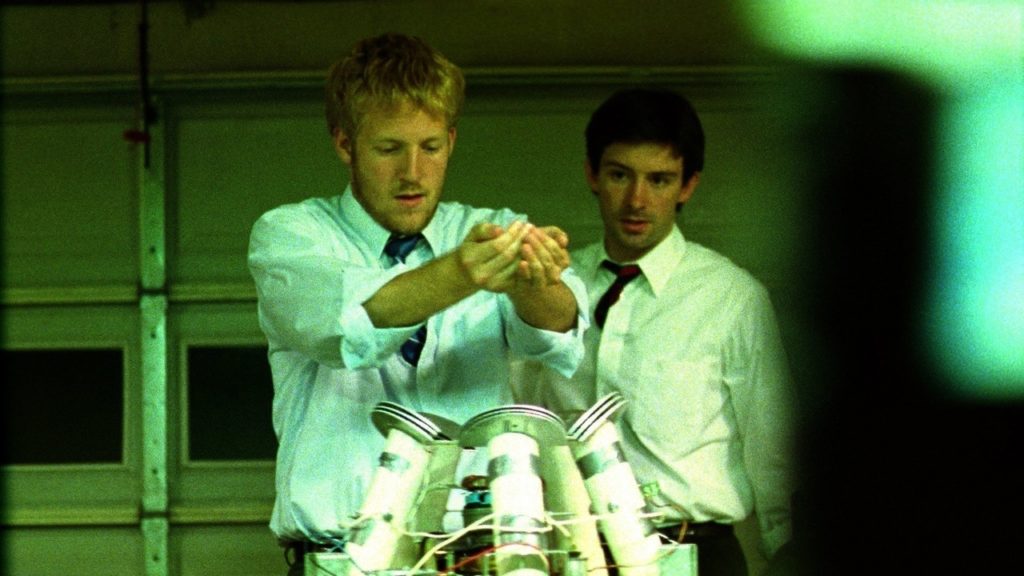Primer
2004

Rated: PG-13
Genre: Sci-Fi, Drama, Thriller
Country: U.S.
Run-Time: 1h 17min
Director: Shane Carruth
Cast
David Sullivan………………Abe
Shane Carruth……………..Aaron
Carrie Crawford……………Kara
There are few movies I have watched more times than Primer. The film is a true oddity. On first watch, the pieces won’t seem to fit, and yet a quick search online reveals that many have taken the time to make sense of this puzzle. At one hour and seventeen minutes, Primer also has a short enough run-time to allow you time to re-watch all the confusing bits to gain a better understanding. But know matter how you feel about it after watching, there is little doubt that Primer is one of those special boundary pushing films that can be classified as an “experience”.
Primer is a film about two engineers, Abe (David Sullivan) and Aaron (Shane Carruth). After work, the two men spend their nights developing tech-projects in the hopes of coming up with a breakthrough invention. When we first meet the men, they are clearly having a disagreement with their partners on which project to work on next. They don’t win the argument, so they carry on with their newest project in secret on their own.
During one of their private inventing sessions, Aaron and Abe create a machine that seemingly makes the objects inside weigh less, but they cannot explain why the objects that go in come out moldy. Abe works diligently to understand the mold issue only to suspect that the objects in the box are really are getting caught in a temporal loop, travelling back in time to the point where the machine was turned on and then back again until breaking the loop. This, of course, causes Abe to wonder if a human could enter a bigger, more stabilized time loop machine and got out at the midpoint, could they safely travel back in time to the point the machine was turned on.
Naturally, by the time Abe tells Aaron, he has already tried it. At first, the two wisely work out a plan the play the stock market each day, choosing to lay low in a hotel after turning on the machine to avoid worries of people seeing one of them in two locations. (For a few hours, two versions of Abe and Aaron will exist in the timeline.) After they learn where to put there money, they then enter the machine, erasing one version of themselves from the timeline. At first, the plan works and it would continue to work if they could stick to the plan. But as the film progresses, the time experiments get bolder and more careless as we watch snippets of five wild days involving duplicate selves, paradoxes, kidnapping, abusive ex-boyfriends, physical breakdowns, nosey investors, secrets, and double crosses.
The story of Primer is as unique as the film itself. Shane Carruth, a former engineer, wrote the screenplay for this film he would eventually direct, produce, score and star in. The film reportedly cost Carruth $7000 to make. Carruth’s film was then selected to be shown at the 2004 Sundance Festival where it ended up winning a Grand Jury Prize. It was then given a limited screening, grossing over $800 000. Later it would be picked up by multiple streaming platforms, all the while gaining a cult reputation. Not a bad return on investment.
One of the things that makes Primer so fascinating is Carruth’s approach. Carruth sacrifices accessibility for authenticity. His film is full of technical jargon that is hard to follow, especially before you know where the film is heading. Each new scene feels like you are eavesdropping in the middle of a difficult conversation, and this replaces scenes other films would dedicate towards long exposition. Aaron narrates some parts in voice over, but even then we are hearing a monologue intended for someone better aware of events, so much of what he says seems cryptic to us. But the mystery and confusion are also effective at creating a constant mood of unease in the viewer, hinting at more ominous things to come. The latter half of the film flows with a kind of dream logic that reminds me a little of Kiyoshi Kurosawa’s Cure or Pulse. But if you take the time to watch and re-watch Primer it does make sense; however, you need to pay attention a lot of the plot is revealed in the two men’s conversations.
Considering the budget, Primer has the look of a fully produced project. The cinematography is competent, sometimes even artistic and the musical score sounds professional. The film only succeeds because Carruth is a man of multiple creative talent. Even the acting is strong, which is why Carruth and Sullivan continued to land acting roles after their debut in Primer. But its that interesting dynamic between Aaron and Abe that helps to carry the film. Most of the time, Abe approaches time travel with caution. Aaron, in contrast, is much more willing to take risks and lacks the moral capital necessary to evaluate the consequences. Yet, he is the one with a family. At the start, the two men appear unified in how to use their invention, but their differences in personality slowly create divisions as they come to realize that both have been withholding information from the other.
Primer tells a cautionary tale about the dangers of messing around with the timeline, but it does so in way that is shockingly original and realistic. It is a time travel tale for the thinking man and woman. (Nobody here steps on a butterfly and brings about Nazi rule.) Even if you don’t- and without help, you probably won’t- understand everything the two men have done, you know things have gotten ugly and ethically complicated. The time machine takes a psychological toll on the men that ends up putting both (all) into a state of constant paranoia. And to think, Primer only shows week one with the time machine. I can’t even fathom what week two might look like.
Although Primer is a science fiction film, there is a uniqueness to its presentation that almost makes it feel like it marks the start of a new hard science genre, a genre that at this moment also, in my opinion, includes Coherence. Horror is often the genre used by directors working with limited budgets. But Carruth shows ambitious young directors that you can also be successful combining high concept science with innovative film techniques. I wouldn’t be surprised if more films like this pop up over the coming decades. That people continue to post new online articles and videos about Primer shows that there exists an audience for these types of films.
